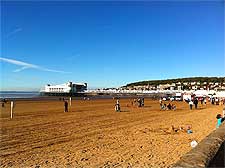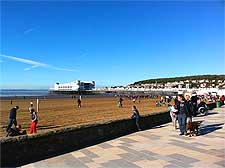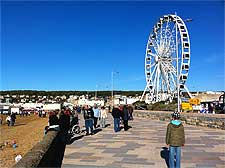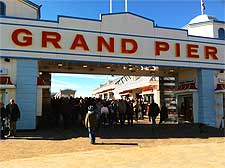Weston Super Mare History Facts and Timeline
(Weston Super Mare, North Somerset, England)

Weston Super Mare's rise from being a small village to a lively seaside resort is a relatively recent event in the town's history. Today, the town - often known as just Weston, is home to around 80,000 people.
The town's name is thought to derive from a mixture of Saxon and Latin words. Weston probably started out as 'west tun', meaning 'the west settlement'. The words 'super' and 'mare' come from the Latin for 'on the sea'.
Earliest Origins
Weston Super Mare started out life as an Iron Age hill fort, situated above the present site of the town. There's also evidence of Roman occupation in parts of the town. By the time the Romans departed in the 5th century AD, Weston was still very much a small village made up of only a few cottages. Most of its inhabitants were engaged in farming or fishing. Then, in the 16th century, a form of zinc ore was discovered on land near to the town. A nascent mining industry was born here, which slowly began to grow.

The Rise of a Seaside Town
The 18th century saw the rise in popularity of sea bathing. Weston Super Mare's close proximity to
Bristol and
Bath meant that it wasn't long before the first bathing machines appeared on its beaches. In 1810, the town's very first hotel was built. Part of this original hotel can still be seen within the present-day Royal Hotel. In 1820, a spa bath was also opened on the island of Knightstone. The publication of a travel guide in 1822 revealed the town's attractions. Whilst these may seem modest to today's holiday makers, visitors at that time didn't expect more than the odd boat ride or a walk through Weston woods.

In 1841, Weston Super Mare was finally connected with Bristol by the Bristol and Exeter Railway. The train carriages had to be drawn part of the way to the station by horses, as some residents had complained that they didn't want noisy steam engines operating in the town. The station was also at the end of a branch line. It wasn't until 1884 that a through station was built, making the resort much more popular with day trippers. Thousands of visitors also came by steamer from
Wales.
Town improvements began in earnest from the mid-19th century onwards. In 1867, Birnbeck Pier was completed. Piers provided visitors with a place where they could stroll and take in the recuperative sea air. Then, in the 1880s, approval was given to build sea walls, along with a lengthy promenade.

20th Century History
By the dawn of a new century, visitors to Weston Super Mare were spoilt for choice when it came to entertainment. Most headed to Birnbeck Pier, which boasted a huge choice of things to do. In fact, there was almost so much on offer that many didn't bother to venture into the town at all. To remedy this, a new pier was built much closer to town. It opened in 1904 and housed a large theatre.
The period between the two World Wars saw many developments for the town. A Marine Lake was built, along with the Winter Gardens and Pavilion. In 1936, the town even acquired its own airport. During the annual Whitsun holidays in 1937, over 2,500 passengers travelled by air to Weston Super Mare. It must have been an astonishing number at that time.
In World War Two, bombing raids on Weston Super Mare wreaked considerable havoc and this period will be remembered as a bleak time in local history. Parts of the town that were destroyed included the Boulevard and the High Street. After the war, the town was forced to reconsider its future. During the war years, new industries had made their home here, including aircraft manufacturing. British seaside resorts were also facing foreign competition. In recent years, the redevelopment of the Pier, following a devastating fire, along with the preservation of the town's parks and beaches have all helped to bring Weston Super Mare into the 21st century.
 Weston Super Mare's rise from being a small village to a lively seaside resort is a relatively recent event in the town's history. Today, the town - often known as just Weston, is home to around 80,000 people.
Weston Super Mare's rise from being a small village to a lively seaside resort is a relatively recent event in the town's history. Today, the town - often known as just Weston, is home to around 80,000 people.
 In 1841, Weston Super Mare was finally connected with Bristol by the Bristol and Exeter Railway. The train carriages had to be drawn part of the way to the station by horses, as some residents had complained that they didn't want noisy steam engines operating in the town. The station was also at the end of a branch line. It wasn't until 1884 that a through station was built, making the resort much more popular with day trippers. Thousands of visitors also came by steamer from Wales.
In 1841, Weston Super Mare was finally connected with Bristol by the Bristol and Exeter Railway. The train carriages had to be drawn part of the way to the station by horses, as some residents had complained that they didn't want noisy steam engines operating in the town. The station was also at the end of a branch line. It wasn't until 1884 that a through station was built, making the resort much more popular with day trippers. Thousands of visitors also came by steamer from Wales.